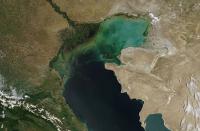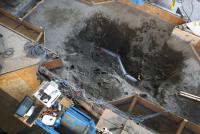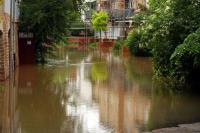-
Brazil’s sewage woes reflect the growing global water quality crisis

All eyes are turned toward Rio de Janeiro to watch top athletes compete, yet the headlines continue to highlight the problems with the water quality and the risks to the athletes who swim, row, and sail, and even to tourists simply visiting the beaches. But Brazil’s wastewater woes are hardly unique. The water quality of lakes, rivers, and coastal shorelines around the world is degrading at an alarming rate. In fact, pollution of the ten largest rivers on earth is so significant that it affects five billion people. While the spotlight is shining on the athletes over the next few weeks, let us also shine a spotlight on what we can do to improve and restore water quality around the world through our collective efforts, use of new tools, and risk frameworks, moving the political will one step closer toward sewage treatment and protection of the biohealth of the blue planet.
-
-
Belarus’s lax approach to nuclear safety raises fear of another Chernobyl

Thirty years after Chernobyl, the world’s worst nuclear accident, a series of mishaps at a nuclear facility in Astravets, in Belarus, has raised concerns over nuclear safety, especially in neighboring Lithuania. Vilnius, the country’s capital, is located less than thirty-one miles from Astravets. Lithuania, accusing Belrus of Soviet era-like lack of transparency, says it would work with the international community to block the Astravets plant coming online.
-
-
Build disaster-proof homes before storms strike, not afterward
There are many technologies we can use to make our buildings more hazard-resistant. But we are not using them as extensively as we should. Instead of designing a building to reduce potential damage from the hazards it may face over its lifetime, most construction projects focus on saving money up front. By choosing the lowest construction cost possible, homeowners, insurance agencies, and taxpayers may end up paying for it many times over when natural disasters occur. To prevent the devastation from another storm, twister, or quake, we need to make deep investments nationwide in mitigation now, before the next disaster strikes.
-
-
Trading farmland to protect water from nitrogen

Excess nitrogen from agricultural runoff can enter surface waters with devastating effects. Algal blooms and fish kills are a just a couple of possible consequences. But riparian buffer zones – areas of grasses, perennials, or trees – between farmlands and streams or rivers can help. But what kind of vegetation makes buffer zones most efficient at removing nitrogen from runoff? A new study sets out to answer.
-
-
How to generate energy during earthquakes
Physics students from the University of Leicester have explored a feasible way to harness the power of earthquakes during a disaster in order to keep vital systems powered. By using a magnet inside a coil during the shaking of tectonic plates that occurs during an earthquake, the students suggest that the magnetic field created by the shaking could generate a current which could potentially be harnessed.
-
-
Climate risk and the fossil fuel industry
Burning coal, oil, and natural gas is responsible for two-thirds of the world’s greenhouse gas emissions. Yet these same fuels are also the economic mainstay of resource-rich countries and the world’s largest companies. According to a new study, this means that climate-change relief actions represent danger for the fossil fuel business.
-
-
Fort Collins, Colorado, using NIST guide to bolster community resilience
Guided in part by strategies and procedures developed by NIST for creating effective and affordable community resilience, the city of Fort Collins, Colorado, is making a commitment to “deal with prospects of future weather- and climate-related challenges that put our community at greater risk,” according to Mayor Pro Tem Gerry Horak.
-
-
Electric grid vulnerabilities in extreme weather areas
Climate and energy scientists at the DoE’s Oak Ridge National Laboratory have developed a new method to pinpoint which electrical service areas will be most vulnerable as populations grow and temperatures rise. The scientists’ integrated approach – combining ORNL’s unique infrastructure and population datasets with high-resolution climate simulations run on the lab’s Titan supercomputer — identifies substations at the neighborhood level and determines their ability to handle additional demand based on predicted changes in climate and population.
-
-
Earthquake-resilient pipeline could allow Los Angeles’s water utility system withstand tremors

Los Angeles’s water utility system – the nation’s largest — crosses over thirty fault lines en route to supplying water to more than four million residents. A top engineer from the city of Los Angeles visited Cornell University this month as researchers tested a new earthquake-resilient pipeline designed better to protect southern California’s water utility network from natural disasters. The steel pipe uses a unique structural wave design to control buckling, allowing the pipe to bend and compress without rupturing or losing water pressure.
-
-
Flood-related losses in Germany to increase under climate change

Flood-related losses can be expected to increase considerably in Germany as a result of climate change, a new study shows. Extreme events like the severe floods along the river Elbe have already illustrated the potentially devastating consequences of certain weather conditions such as severe rainfall events, when continuing intense rain can no longer be absorbed by the soil and water levels in the rivers rise. Without appropriate adaptation, flood-related damage of currently about €500 million a year could multiply in the future, according to the comprehensive expert analysis.
-
-
Studying the basic science of nuclear waste
Approximately 300 million liters of highly radioactive wastes are stored in hundreds of underground tanks at the Hanford Site in Washington and the Savannah River Site in South Carolina. These wastes are extremely complicated mixtures of salts and sludges that have been exposed to ionizing radiation for decades. Their chemistry is dominated by interactions at solid-liquid interfaces that are poorly understood. A more thorough understanding of the chemistry of radioactive waste is key to treating this unwanted byproduct of winning the Second World War and the cold war.
-
-
Cities face dramatic increase in water treatment spending when watersheds are damaged
A new global study has found that one in three large cities spend 50 percent more on water treatment costs as a result of damage to the ecological quality of their watersheds. This study found that urban source watershed degradation is widespread globally, with 9 in 10 cities losing significant amounts of natural land cover to agriculture and development in the watersheds that supply their drinking water. This has led to polluted water and an increase in water treatment costs that represent a liability in excess of $100 billion.
-
-
New research predicts a doubling of coastal erosion by mid-century in Hawai’i
Chronic erosion dominates the sandy beaches of Hawai’i, causing beach loss as it damages homes, infrastructure, and critical habitat. Researchers have long understood that global sea level rise will affect the rate of coastal erosion. Newresearch team developed a simple model to assess future erosion hazards under higher sea levels.
-
-
Cape Cod susceptible to potential effects of sea-level rise
Cape Cod is vulnerable to rising water tables and, in some areas, groundwater inundation as a result of rising sea levels, according to a new U.S. Geological Survey study (USGS). Groundwater inundation occurs when the water table reaches or exceeds land surface. The challenges associated with the issue are likely to become more prevalent as seas rise. Depending on the severity, it may make areas unsuitable for residential and commercial development.
-
-
As nuclear power plants close, states need to bet big on energy storage
Nuclear power plants saw their heyday in the early 1970s and were praised for their ability to produce large amounts of electricity at a constant rate without the use of fossil fuels. We are now observing a trend whereby long-running nuclear power plants are shutting down, and of utilities moving toward renewable electricity generation, such as solar and wind. Can utilities supply electricity around the clock using these alternative generation sources? And crucially, can energy storage technologies provide the power on demand that traditional generators have done? It is clear that energy storage is the major limitation to achieving a carbon-free electricity grid. Careful planning is needed to ensure that energy storage systems are installed to take over the baseline load duties currently held by natural gas and nuclear power, as renewables and energy efficiency may not be able to carry the burden.
-
More headlines
The long view
Helping Strengthen America’s Critical Infrastructure
Everyday life depends on a robust infrastructure network that provides access to running water, communications technology and electricity, among other basic necessities. The experts who keep our national infrastructure secure and resilient also need a strong network to share their knowledge and train the next generation of professionals capable of solving complex infrastructure challenges.
AI and the Future of the U.S. Electric Grid
Despite its age, the U.S. electric grid remains one of the great workhorses of modern life. Whether it can maintain that performance over the next few years may determine how well the U.S. competes in an AI-driven world.
Using Liquid Air for Grid-Scale Energy Storage
New research finds liquid air energy storage could be the lowest-cost option for ensuring a continuous power supply on a future grid dominated by carbon-free but intermittent sources of electricity.
Enhanced Geothermal Systems: A Promising Source of Round-the-Clock Energy
With its capacity to provide 24/7 power, many are warming up to the prospect of geothermal energy. Scientists are currently working to advance human-made reservoirs in Earth’s deep subsurface to stimulate the activity that exists within natural geothermal systems.
Experts Discuss Geothermal Potential
Geothermal energy harnesses the heat from within Earth—the term comes from the Greek words geo (earth) and therme (heat). It is an energy source that has the potential to power all our energy needs for billions of years.
